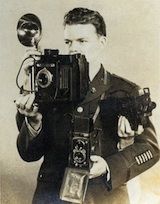- Forum
- Photography and Camera Forum
- Taking the Photo | Editing | The art of Photography!
- Editing and Presentation
- RAW Format worthwhile as an archive copy?
RAW Format worthwhile as an archive copy?
-
 Topic Author
Topic Author
- fallenhunter
- Newbie
- Follower: 1
- Posts: 5
-
Points:
0
Post #136671
I do intend to learn to edit/use the RAW, but as of right now, I do not have the software.
My main concern is that I take two shots with this setup in a row, and the buffer is full and I have to wait, which means I loose other shots. (I know that this will speed up if I just have the Large JPG and forgo the RAW for sports shots, and do).
If the RAW does not make a good backup/archive/negitive, then at least till I learn to use the software for it, I will stop shooting in ti.
Also, I shoot Canon (CR2), RAW files, and are looking for an open sourced program to use with it. I Use Gimp for most of my corrections and cropping needs. ( Yes I am an Open Source Fan!).
One last thing... I know the software that comes with my camera (Canon EOS Ti3), allows you to remote view, take pictures, change settings etc, on your PC. I am wondering if there is an more complete program that allows time lapse photography, and other effects (Flash Sync, comes to mind).
Thanks to all you experts who will provide expert care and info.
Dwayne Miller
Wooster, Ohio USA
www.photographytalk.com/components/com_k...moticons/patriot.gif
-

- MLKstudios
- Banned
-
- D800 ;-)
- Followers: 72
- Posts: 4480
-
Points:
2
Post #136707
The advantage of using RAW (or DNG) to archive, is that you have saved every single pixel the camera took when you pressed the shutter button. If you get better in your post work, you can go back to them and re-edit them to make them better than before.
Also, in the future, new software may give you even more choices for editing -- with more dynamic range.
So yes, keeping the RAW is like keeping a film negative. It's the original and can be re-used over and over again.
The software Canon gave you has the ability to edit the camera's RAW files too.
Matthew
Matthew L Kees
MLK Studios Photography School
www.MLKstudios.com
[email protected]
"Every artist, was once an amateur"
Post #136791
“Amateurs worry about equipment, professionals worry about money, masters worry about light, I just make pictures… ” ~ Vernon Trent
-
 Topic Author
Topic Author
- fallenhunter
- Newbie
- Follower: 1
- Posts: 5
-
Points:
0
Post #138103
Sounds like I will keep shooting RAW and learn some more software.
Fallenhunter
-

- Baydream
- Moderator
-
- Canoni/60D/70D/5DmkIII
- Followers: 388
- Posts: 11185
-
Points:
7280
Post #138112
Free Picasa will edit CR2 files (as well as most RAW formats). It is not as comprehensive an editor as many but easy to use (and will do a lot of the basic things many people do). Give it a try at www.picasa.com . The help and tutorials are first rate.fallenhunter wrote: Thank you for your reply (sorry about this taking so long, real life sucks).
Sounds like I will keep shooting RAW and learn some more software.
Fallenhunter
Shoot, learn and share. It will make you a better photographer.
fineartamerica.com/profiles/john-g-schickler.html?tab=artwork
-
 Topic Author
Topic Author
- fallenhunter
- Newbie
- Follower: 1
- Posts: 5
-
Points:
0
Post #138125
Thank you!
-

- photobod
- Paparazzi
-
- Nikon D800 + D300
- Followers: 563
- Posts: 8907
-
Points:
150
Post #138274
www.dcimages.org.uk
"A good photograph is one that communicate a fact, touches the heart, leaves the viewer a changed person for having seen it. It is, in a word, effective." - Irving Penn
-

- Henry Peach
- Apprentice
-
- I currently use a 5DII or Sony Nex-3 most of the time.
- Followers: 50
- Posts: 2925
-
Points:
16
Post #138902
MLKstudios wrote: The advantage of using RAW (or DNG) to archive, is that you have saved every single pixel the camera took when you pressed the shutter button. If you get better in your post work, you can go back to them and re-edit them to make them better than before.
Also, in the future, new software may give you even more choices for editing -- with more dynamic range.
I only discard the raw files if I am 110% positive that I will never, ever want to re-process the photo.
Possibly faster memory cards would allow you to take more pics before the buffer filled. Even my oldest DSLRs could take 6 to 8 shots in a row before bogging down. I was shooting raw only though.
- Forum
- Photography and Camera Forum
- Taking the Photo | Editing | The art of Photography!
- Editing and Presentation
- RAW Format worthwhile as an archive copy?
Latest Reviews
The Olympus Pen E-P7 is an affordable micro four thirds mirrorless camera with 4K video capabilities, a 20.3MP sensor, and 121 focus points, making it a solid entry-level camera for beginners.
The Panasonic G9 II is a 25.2-megapixel micro four thirds camera with numerous features that make it punch out of its weight class, like 779 AF points, 5.8K video, and weather sealing.
The Fujifilm XT5 is a 40MP mirrorless camera capable of 6.2K video at 30p. With those specs, it’s an ideal choice for photographers needing a camera to pull double duty for imaging and video.
The Canon EOS R100 is an entry-level mirrorless camera introduced in 2023. But just because it’s an entry-level camera doesn’t mean it’s a bare-bones camera. Find out why in this review!
Forum Top Posters
-
1Scotty 2 posts
-
2katherineb... 2 posts
-
3Shadowfixe... 1 post
-
4James F 1 post
-
5Esseff 1 post
Latest Articles
Tree photography is an interesting genre of landscapes that use the size, shape, and texture of trees as the primary element of interest. With these quick tips, you can master the art of photographing trees!
Auto white balance is a camera setting that adjusts the color temperature of your images automatically. It often works well, but you should know a few tips to fix problems it might cause, too.
The Canon EOS 5D Mark III might be more than a decade old, but it still has the chops to be a quality camera for photographers in 2024.
Starting a photography business can be a daunting task. There is a lot to do, and many mistakes can be made. This guide helps you minimize mistakes and maximize your success!
The Canon 6D Mark II might be an older DSLR, but that doesn’t mean it isn’t a good option for 2024. In fact, this budget-friendly camera is a powerhouse for stills and videos.
In this guide to the bokeh effect, you’ll learn what bokeh is and the factors involved in creating it. You’ll also explore some beautiful example images to spark your creativity with bokeh!
Upgrade your kit in 2024 with the best intermediate camera on the market! The question is, what camera fits the bill? We’ve got three top options for you to choose from in this buyer’s guide.
The best photography jobs right now are a mix of tried-and-true gigs like wedding photography and new jobs highlighting AI’s capabilities, travel, and videography.
















